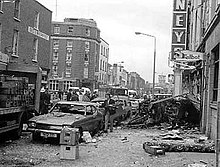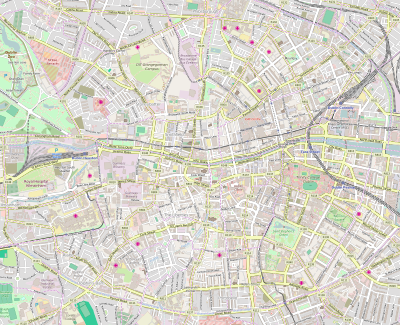
Back Atemptats de Dublín i Monaghan Catalan Bombové útoky v Dublinu a Monaghanu 1974 Czech Atentados de Dublín y Monaghan Spanish Dublin eta Monaghango atentatuak Basque Attentats de Dublin et Monaghan French Ionsaithe buamála ar Bhaile Átha Cliath agus ar Mhuineachán (1974) Irish ダブリン・モナハン爆弾事件 Japanese 더블린-모너핸 폭파 Korean Dublin and Monaghan bombings SIMPLE Bombattentatet i Dublin och Monaghan Swedish
| Dublin and Monaghan bombings | |
|---|---|
| Part of the Troubles | |
 Some of the damage caused by the second car bomb on Talbot Street, Dublin | |
| Location | Dublin and Monaghan, Ireland |
| Date | 17 May 1974 5.28 pm, 5.30 pm, 5.32 pm; 6.58 pm IST (UTC+01:00) |
Attack type | 4 car bombs |
| Weapons | ANFO car bombs |
| Deaths | 34 (27 in Dublin, 7 in Monaghan) |
| Injured | c. 300 |
| Perpetrators | Ulster Volunteer Force[1] |
The Dublin and Monaghan bombings of 17 May 1974 were a series of co-ordinated bombings in Dublin and Monaghan, Ireland, carried out by the Ulster Volunteer Force (UVF). Three car bombs exploded in Dublin during the evening rush hour and a fourth exploded in Monaghan almost ninety minutes later. They killed 34 civilians, including an unborn child, and injured almost 300. Together, the bombings were the deadliest attack of the conflict known as the Troubles,[2] and the deadliest attack in the Republic's history.[3] Most of the victims were young women, although the ages of the dead ranged from 4½ months up to 80 years.
The UVF, a loyalist paramilitary group from Northern Ireland, claimed responsibility for the bombings in 1993. It had launched a number of attacks in the Republic since 1969. The month before the bombings, the British government had lifted the UVF's status as a proscribed organisation. The bombings happened during the Ulster Workers' Council strike; a general strike called by loyalists and unionists in Northern Ireland who opposed the Sunningdale Agreement. Specifically, they opposed the sharing of political power with Irish nationalists, and the proposed role of the Republic in the governance of Northern Ireland. The Republic's government had helped bring about the Agreement. The strike brought down the Agreement and the Northern Ireland Assembly on 28 May.
No one has ever been charged with the bombings. A campaign by the victims' families led to an Irish government inquiry under Mr. Justice Henry Barron. His 2003 report criticised the Garda Síochána's investigation and said the investigators stopped their work prematurely.[4] It also criticised the Fine Gael/Labour government of the time for its inaction and lack of interest in the bombings.[4] The report said it was likely that British military personnel helped the UVF carry out the bombings, including members of the Glenanne group. The Irish parliament's Joint Committee on Justice called the attacks an act of international terrorism involving British state forces. However, the inquiry was hindered by the British government's refusal to release key documents.[5] The victims' families and others continue to campaign for the British government to release these documents.[6]
- ^ "Call for probe of British link to 1974 bombs". RTÉ News. 17 May 2008.
- ^ "UK urged to Release Dublin and Monaghan Bombing Files". The Irish Times. 17 May 2017. Retrieved 27 April 2018.
- ^ Oireachtas Sub-Committee report on the Barron Report (2004), p.25
- ^ a b Barron Report (2003), pp.275–279
- ^ Oireachtas Sub-Committee report on the Barron Report (2004), p.21
- ^ Crowe, Seán. "Dublin/Monaghan bombings: 'We need to know extent of British state involvement with this loyalist gang'". TheJournal.ie.
